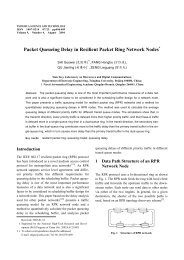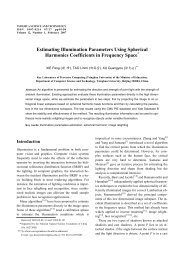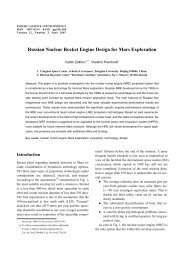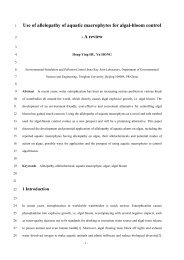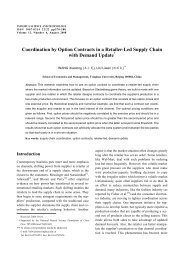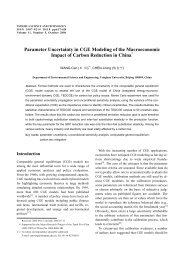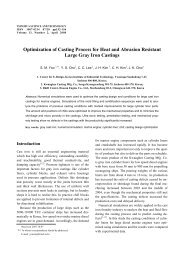Information Sharing in a Multi-Echelon Inventory System
Information Sharing in a Multi-Echelon Inventory System
Information Sharing in a Multi-Echelon Inventory System
You also want an ePaper? Increase the reach of your titles
YUMPU automatically turns print PDFs into web optimized ePapers that Google loves.
472<br />
{ | , ( ) }<br />
Ts<strong>in</strong>ghua Science and Technology, August 2007, 12(4): 466-474<br />
P x′ 0 x0 a0 x0<br />
=<br />
ϕ0 ϕ0<br />
π0 (1) , , π0<br />
( U0)}<br />
for this policy are obta<strong>in</strong>ed by<br />
⎧ o0( x0, x0 + a0( x0) − x′ 0), ⎪ U1<br />
⎪<br />
⎨ ∑ o0( x0, b), ⎪b=<br />
x0+ a0( x0)<br />
⎪<br />
⎩ 0,<br />
if x0 + a0( x0) ≥ x′<br />
0 > 0;<br />
if x′<br />
0 = 0;<br />
if x′ 0 > x0 + a0( x0)<br />
solv<strong>in</strong>g the DTMDP.<br />
The retailer’s state space and action space are<br />
S1 = { ( x0, x1) | 0≤xi ≤ Ui, i = 01 , } (38)<br />
A1( x0, x1) = { 0,1, , U1 − x1}<br />
(39)<br />
(37) For the RDIS scenario, the retailer knows the sup-<br />
Therefore, with a given retailer’s order distribution<br />
matrix O 1 , { x0, a0( x0)<br />
} is a DTMDP. Analogously,<br />
the order<strong>in</strong>g policy ϕ 0 = { a0(0) , a0(1) , , a0( U0)<br />
} and<br />
plier’s order<strong>in</strong>g policy ϕ 0 and stationary state distri-<br />
ϕ0<br />
bution Φ 0 . Given policy ϕ 0 , the retailer’s one-step<br />
transition probability from state ( x0, x1)<br />
to ( x′ 0, x′<br />
1)<br />
the state stationary distribution<br />
ϕ0 Φ0 ϕ0<br />
= { π0<br />
(0) , with action a1( x0, x1)<br />
is<br />
P{ ( x′ 0, x′ 1) | ( x0, x1) , a1( x0, x1)<br />
} =<br />
ϕ0<br />
+<br />
⎧ 1 { x′ 0 = ( x0 + a0 ( x0) − a1( x0, x1)) } ⋅ P{ D = x1 + m− x′ 1} ,<br />
⎪<br />
ϕ0<br />
+<br />
⎨1<br />
{ x′ 0 = ( x0 + a0 ( x0) − a1( x0, x1)) } ⋅ P{ D≥x1 + m} ,<br />
⎪<br />
⎪⎩<br />
0,<br />
if 0 < x′ 1≤x1 + m;<br />
if x′<br />
1 = 0;<br />
if x′ 1 > x1 + m<br />
(40)<br />
ϕ0<br />
where m m<strong>in</strong> { a1( x0 x1) x0 a0 ( x0)<br />
}<br />
= , , + .<br />
ϕ 0 1<br />
For a given supplier’s order<strong>in</strong>g policy 0 , {( x , x ) ,<br />
a1( x0, x 1)}<br />
is a DTMDP. The DTMDP solution gives<br />
the order<strong>in</strong>g policy ϕ 1 = { a1( x0, x1) ∈ A1( x0, x1) , ( x0, x1)<br />
∈<br />
S and the stationary state distribution ϕ1<br />
Φ =<br />
1 }<br />
ϕ1<br />
{ π1 ( x0, x1),( x0, x1) ∈ S1}<br />
of the retailer. If { ϕ0, ϕ 1}<br />
is<br />
an equilibrium po<strong>in</strong>t policy, then the def<strong>in</strong>ition of the<br />
order<strong>in</strong>g distribution matrix, O 1 , leads to<br />
o (, i j)<br />
=<br />
1<br />
U1<br />
∑<br />
b=<br />
0<br />
ϕ1 ϕ1<br />
1 1<br />
U1<br />
b=<br />
0<br />
ϕ1<br />
1<br />
{ }<br />
π ( ib , ) ⋅ 1 a ( ib , ) = j<br />
∑<br />
π ( ib , )<br />
for all i∈S0, j∈ A1<br />
(41)<br />
Therefore, the iterative algorithm to search for the<br />
order<strong>in</strong>g distribution matrix O 1 is as follows.<br />
Algorithm 4<br />
Step 1: Set <strong>in</strong>itial values of O 1 andε .<br />
Step 2: Solve the supplier’s DTMDP to obta<strong>in</strong> the<br />
supplier’s order<strong>in</strong>g policy ϕ 0 .<br />
Step 3: Solve the retailer’s DTMDP to obta<strong>in</strong> the<br />
retailer’s order<strong>in</strong>g policy ϕ 1 and the stationary<br />
ϕ1<br />
distribution Φ 1 .<br />
,<br />
1<br />
Step 4: Update the order<strong>in</strong>g distribution matrix 1 ′<br />
O<br />
us<strong>in</strong>g Eq. (41).<br />
Step 5: If ∆( O1 − O ′ 1)<br />
< ε , stop; otherwise let O ′ 1<br />
be the new order<strong>in</strong>g distribution matrix and return to<br />
Step 2, where ∆( O1 − O′ 1) =|| O ′ 1 − O 1||<br />
.<br />
4 Numerical Comparisons and<br />
Analyses<br />
The algorithms for the s<strong>in</strong>gle supplier-s<strong>in</strong>gle retailer<br />
supply cha<strong>in</strong>s with various <strong>in</strong>formation shar<strong>in</strong>g scenarios<br />
were developed to determ<strong>in</strong>e their <strong>in</strong>ventory policies.<br />
The different <strong>in</strong>formation shar<strong>in</strong>g scenarios will<br />
result <strong>in</strong> different total expected long-run-average costs<br />
of the supply cha<strong>in</strong>s. The algorithms were studied numerically<br />
to show the valuation of the total cost with<br />
respect to the <strong>in</strong>formation shar<strong>in</strong>g scenarios.<br />
The analyses calculated the equilibrium po<strong>in</strong>ts us<strong>in</strong>g<br />
randomly generated groups of system parameters. The<br />
demand process at the retailer was assumed to follow a<br />
Poisson process with parameter λ . The parameters<br />
were generated with<strong>in</strong> the ranges listed <strong>in</strong> Table 1.<br />
Table 1 Parameters’ range<br />
h0 h1 p0 p1 K0 K1 λ<br />
[0.1, 3.0] [h 0, h 0+3.0] [h 0,15h 0] [h 1,15h 1] [0, 60h 0] [0, 20h 1] [0.5, 6.5]



